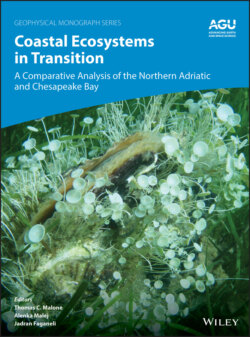Читать книгу Coastal Ecosystems in Transition - Группа авторов - Страница 33
2.4.2. Controlling Factors
ОглавлениеIn the CB watershed, several controlling factors have been identified for nutrient export in the Susquehanna River (Zhang, Ball, et al., 2016). First, river flow dominates the interannual variability of constituent export. Second, land‐use patterns strongly affect the relative contribution of the subwatersheds. Specifically, long‐term median yields of N, P, and SS all correlate positively with the fraction of the watershed that is not forested. Third, riverine loads from different Susquehanna subwatersheds have generally declined due to reductions in source input over the same period. Finally, dams and reservoirs can strongly modulate the storage and release of particulate constituents and the extent of modulation has varied considerably over time as reservoirs fill. Two decades ago, the Conowingo Reservoir and two others in the lower Susquehanna River trapped about 2%, 45%, and 70% of annual N, P, and SS load, respectively (Langland & Hainly, 1997). Currently, the reservoir system is no longer an effective trap of these constituents (Hirsch, 2012; Langland, 2015; Zhang et al., 2013; Zhang, Hirsch, et al., 2016).
In the NAS watershed, the annual export of nutrient and sediment is directly linked to river flow and can be estimated using Po River loads as a reference (Cozzi & Giani, 2011). However, the short‐term dynamics of riverine loads are complicated during freshets by the effects of flow on the erosion, groundwater inputs, dilution, and biological processes in the river environment (Marchina et al., 2015; Tesi et al., 2013). The N and P loads in the marine environment have long‐term trends consistent with watershed inputs from industrial activities, agriculture, livestock, urban settlements, and atmospheric deposition; dynamics of their delivery are also modulated by the variable retention of these elements in soils and aquifers (Cozzi et al., 2019; Palmeri et al., 2005; Salvetti et al., 2006; Viaroli et al., 2018). In general, retention mechanisms differ considerably between N and P—sedimentation may be the major retention mechanism for particulate P during overland flow conditions (Cirmo & McDonnell, 1997; Hoffmann et al., 2009), whereas sorption/desorption reactions and denitrification are more important for P and N, respectively, during subsurface flow conditions (House, 2003; Withers & Jarvie, 2008).
